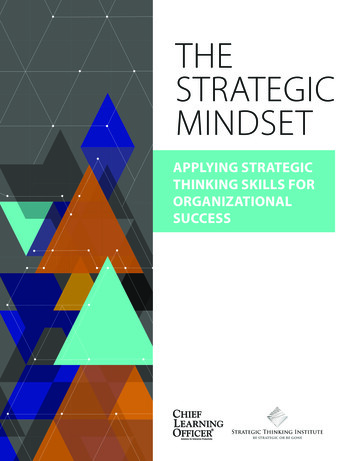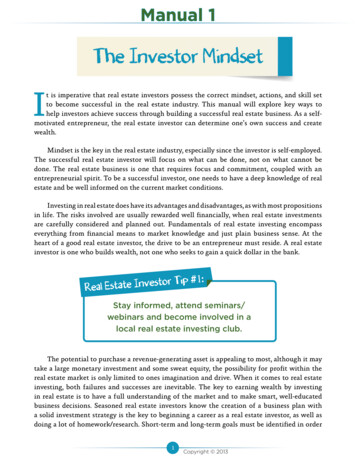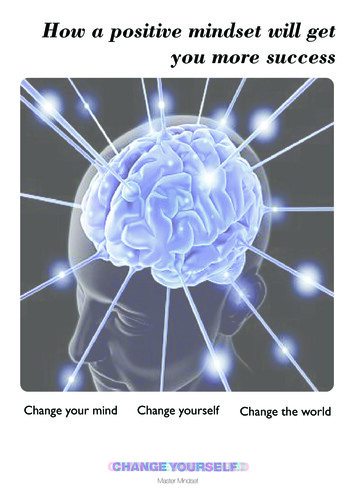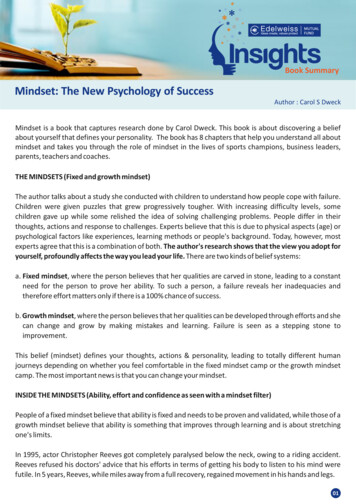
Transcription
theTHESTRATEGICMINDSETAPPLYING STRATEGICTHINKING SKILLS FORORGANIZATIONALSUCCESS
Strategy and its consistent application by managers andleaders are keys to long-term organizational success. Strategyis an essential component of strategic thinking, a necessary skillfor leaders and one that’s highly sought after by employers.1 Beingable to think strategically about the big picture and make reasoneddecisions that will drive employees in the organization in a commondirection means leaders can contribute to business goals.Yet many managers are unclear on exactly what is and isn’t strategy, and howto explain it to others or know how to apply it to their daily activities. Recentlypromoted leaders especially might struggle during the transition to their new role,relying on what’s worked in the past and focusing on short-term tactics. This mayhave proven successful in their previous role, but might not be what the organizationneeds from them now. Organizations may understand the need for strategic thinking, butfew have the right tools in place or the necessary skills to leverage strategic thinking into anenterprise-wide capability for competitive advantage.To gain a better understanding of the current state of strategy skills at organizations, the HumanCapital Media Research and Advisory Group — the research arm of Chief Learning Officer —partnered with the Strategic Thinking Institute for the CLO Strategy Skills survey. We asked surveyrespondents about the degree to which managers at their organization understand strategy, if they cancommunicate and apply strategy, and the extent of current measurement of their organization’s strategyimplementation, application and impact.DEMOGRAPHICSFor full demographics information, see Appendix.The CLO Strategy Skills survey received 400 responses.KEY FINDINGS Strategic thinking is the most important leadershipcapability for senior executives (No. 1 response at 63.7percent). Only 44.3 percent of organizations have a universaldefinition of strategy, while only 46 percent have acommon language for strategy. Strategy skills are taught at just 24.1 percent oforganizations. 83.4 percent of respondents believe managers at theirorganizations would benefit from a greater selection ofthinking and planning tools and models to help themdevelop strategy. Only 31.9 percent of respondents said they teach theirmanagers how to facilitate strategy conversations.1Weisser, C. (2016). “The 21 Most Valuable Career Skills.” Money.2 THE STRATEGIC MINDSET: APPLYING STRATEGIC THINKING SKILLS FOR ORGANIZATIONAL SUCCESS
“Strategic thinking unleashes thepower of managers to solveproblems, overcome challengesand creatively take theBefore we examine best practices for strategic thinking, we shouldstep back and take a big-picture view. Do organizations have abusiness from where it is tocommon definition or understanding of what strategy is?where it needs to go.”STRATEGY: WHAT IS IT?Not many survey respondents believe so. Having a definition is essential forgiving employees an understanding of how strategy differs from the mission,vision, goals, objectives and tactics. Yet less than half of respondents believetheir organizations have either a universal definition (44.3 percent) or a commonlanguage (46 percent) for strategy. Where then to begin?— Rich Horwath, CEO,Strategic Thinking InstituteWhat are the characteristics of strategic thinkers? Among other things, employees whoregularly think strategically generate insights on how to create new value, are able tomake trade-offs with their resources and effectively prioritize their activities. To create auniversal definition, organizations should start with the Strategic Thinking Framework (Figure1). The framework consists of three A’s: acumen, allocation and action. Acumen is where allprojects start — the idea that will lead to new value either for the customer or the organization.Having acumen requires strategic insight — being able to identify opportunities or solve problemsto create and deliver new value.Once the idea has been identified, organizations can move on to the second A: allocation. Budget,resources, people and time should all be considered at this stage. Allocation should reflect strategicinnovation as leaders identify new ways to allocate resources that will deliver value for their customers. Afterresource allocation is determined, organizations can then act on the program or initiative. By focusing strategicthinking through the lens of the framework, organizations free their managers up to focus on the important tasksand not get distracted by fire drills.2 This last part is key: strategy is not tactics, yet only a third of survey respondents(33.2 percent) are teaching their managers how to recognize the difference between strategy and tactics.FIGURE 1: STRATEGIC THINKING FRAMEWORK2 Horwath, R. “The Strategic Thinking Manifesto.” Strategic Thinking Institute.3 THE STRATEGIC MINDSET: APPLYING STRATEGIC THINKING SKILLS FOR ORGANIZATIONAL SUCCESS
PUTTING STRATEGYIN THE CORPORATECLASSROOM“My company does not have strategicthinking and planning tools inplace. Any tools are ‘learned’ onthe job according to whomand what the director’sleadership style is.”For organizations to be able to realize the benefits of strategic thinking, they’llneed to include strategy skills in their leadership development programs.There is plenty of room for improvement in this area, as less than a quarter of allorganizations (24.1 percent) answer Yes on if their organization teaches strategy skills(Figure 2).— Survey respondent, CLOStrategy Skills survey, opencommentsOrganizations looking to develop a strategy skills program can look to what others aredoing for inspiration. Who benefits most from strategy skills training? Organizations mostlyteach strategy skills to middle- and upper-level managers. Strategy skills are often taughtto managers (40.6 percent), directors (42.9 percent) and vice president-level senior leaders(41.4 percent). Common elements in leadership development include how to think strategically,articulate the organizational strategy and apply it to teamwork (Figure 3).FIGURE 2: ARE STRATEGY SKILLSTAUGHT AT YOUR ORGANIZATION?n Yesn To somen NoextentFIGURE 3: ELEMENTS INCLUDED INSTRATEGY EDUCATIONHow to apply theorganizational strategy todepartment/teamworkHow to articulate theorganizational strategy42%24%34%65%60%How to think strategically54%How to use strategyto prioritize tasks53%How to build buy-in fororganizational strategywithin the department/team4 THE STRATEGIC MINDSET: APPLYING STRATEGIC THINKING SKILLS FOR ORGANIZATIONAL SUCCESS45%
“[At our organization, the] emphasisis on short-term results, which isreinforced through behaviors andpractices of senior leadership.Long-term work is notThere’s overwhelming support for managers benefitting from a greaterviewed as a manager’sselection of thinking and planning tools and models to help them developrole.”strategy. More than 8 in 10 survey respondents (83.4 percent) agree with thisPROVIDING THERIGHT TOOLSstatement (Figure 4).One of the greatest tools for strategic thinking is deceptively simple: time. Strategydevelopment takes time to focus on new, unproven areas that will bring value to thebusiness. Leaders need uninterrupted time to both develop their necessary skills andconcentrate on strategic tasks.— Survey respondent, CLOStrategy Skills survey, opencommentsYet finding time is a challenge for many, with 65.9 percent of survey respondents saying thelack of time to engage in strategic skills development is a top challenge to increasing strategyskills. Other challenges include a lack of training on strategy skills and lack of a framework forcreating strategic thinking habits (Figure 5).FIGURE 4: MANAGERS AT OUR ORGANIZATION Would benefit from a greater selection ofthinking/planning tools/models to help them develop strategyUse goals and strategies to drive their daily activitiesEffectively set clear priorities and don’t prioritize everything as importantCan clearly differentiate between strategy andmission vision, goals, objectives and tactics83%56%49%41%FIGURE 5: TOP ROADBLOCKS TO INCREASING STRATEGY SKILLSAMONG MANAGERSLack of a framework to create a habit of strategic thinking66%Lack of available time to engage in strategic skills development66%62%Lack of training on strategy skills among managersLack of understanding of what strategy really is and how to create itLack of a clear definition of strategy among managers53%52%5 THE STRATEGIC MINDSET: APPLYING STRATEGIC THINKING SKILLS FOR ORGANIZATIONAL SUCCESS
COMMUNICATIONIS KEYQ: What is one action you’d like to see yourorganization take in the next year to improvestrategy for managers and leaders?A: Cascade strategic capability and thinkingto middle and lower management levels.A: Set up a common language andframework that is consistent acrossour functional areas.For strategic insight to contribute to organizational success, leaders needto embrace and facilitate strategy conversations, which help them solve theirkey business challenges. Yet there is much room for improvement in this area;only 31.9 percent of respondents said they teach their managers how to facilitatestrategy conversations. The potential value of strategic thinking and planning aredramatically reduced when managers are not able to effectively communicate theirstrategic insights with one another (Figure 6).A: Make this part of theleadership training culture atALL levels.How should managers communicate to be more strategic? Including overarching themesin both written and verbal communications helps the audience connect with the upper-levelmessage. Strategy conversations should be focused on higher-level priorities, not boggeddown in tactical details.FIGURE 6: STRATEGIC COMMUNICATION AT OUR ORGANIZATIONManagers can articulate the objective, scopeand advantage of the business in a single statement50%There is a common language for strategythroughout my organization46%Cross-functional groups coordinate to effectivelyalign their strategies and resolve conflictsWe teach our managers how tofacilitate strategy conversations42%32%6 THE STRATEGIC MINDSET: APPLYING STRATEGIC THINKING SKILLS FOR ORGANIZATIONAL SUCCESS— Survey respondents, CLOStrategy Skills survey, opencomments
“Make strategy skills mission criticalfor the organization by engagingsenior leaders as champions andusing L&D to drive strategyskills learning programsacross the organization.”Organizations looking to reinforce strategy skills should build strategicTHE MOST IMPORTANTLEADERSHIP CAPABILITYthinking into their leadership development programs, to ensure that currentand future leaders have the tools they need to develop and execute strategic— Survey respondent,plans. Strategic thinking is especially crucial for new managers, who may not beCLO Strategy Skills survey, opencommentsready to give up their old tactical duties. Half of all organizations (49.9 percent)agree that managers who aren’t strategic enough — focusing instead too much onthe tactical — aren’t likely to advance their careers. In addition, most organizations(63.7 percent) believe the ability to think strategically and set direction is the mostimportant leadership capability for senior executives. Thus, developing leaders’ strategiccapabilities demonstrates commitment to employee development. By giving leaders thetools and direction they need, managers will spend less time firefighting (reacting to every issuethe minute it crosses their desk) and more time using goals and strategies to drive their dailyactivities (Figure 7).FIGURE 7: MANAGERS AT OUR ORGANIZATION.Use goals and strategies to drive their daily activities56%43%Articulate to others how tasks relate to strategic goalsSpend time on strategic tasks rather than firefighting28%7 THE STRATEGIC MINDSET: APPLYING STRATEGIC THINKING SKILLS FOR ORGANIZATIONAL SUCCESS
“When you think about the pace ofchange in most industries and theincreasing level of competitiondue to digital factors andGood strategy can move organizations in new directions and openchanging business models,them up to new markets and possibilities. The opposite is also true: badstrategy can sink a business. Organizations should ensure their managers,strategic thinking is nodirectors and senior leaders have the same definition of strategy, know whatlonger a nice to have,the strategic direction is for their organization and are able to apply strategicthinking to their department or teamwork. The Strategic Thinking Framework isit’s a must-have.”CONCLUSIONa good place to start when deciding on a common approach to strategy.— Rich Horwath, CEO,Once there is a consistent definition of strategy enterprise-wide, organizations shouldStrategic Thinkinginclude strategy skills into their leadership development programs. Survey respondentsInstituteagree: leaders would benefit from more tools and models to help them develop strategy.Strategy should be communicated throughout the organization by teaching leaders howto facilitate strategy conversations and clearly translate strategy to their teams. Finally, leadersshould recognize that strategy — more so than tactics — will advance both their career andorganizational goals. By making strategic trade-offs and focusing on only a few priorities, leaderswill envision the big picture and be better equipped to handle change and challenges as they arise.APPENDIXGlossaryStrategic innovationInsight-based resourceallocation that will createvalue for target customersegments.Strategic insightA new idea combiningtwo or more pieces ofinformation that willpositively affect businesssuccess and providecompetitive advantage.Strategic planningChanneling insights intoan action plan to achievegoals and objectives.Strategic thinkingThe generation ofinsights to achieveadvantage.ABOUTStrategic Thinking InstituteThe Strategic Thinking Institute is dedicated to helping managers at all levels develop their strategic thinki
4 THE STRATEGIC MINDSET: APPLYING STRATEGIC THINKING SKILLS FOR ORGANIZATIONAL SUCCESS PUTTING STRATEGY IN THE CORPORATE CLASSROOM For organizations to be able to realize the benefits of strategic thinking, they’ll need to include strategy skills in their leadership development programs.











